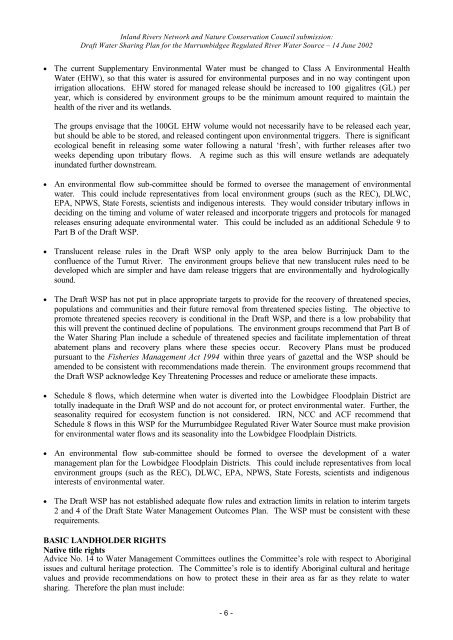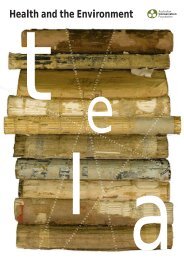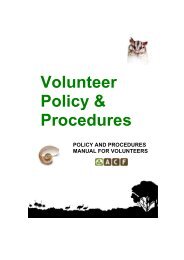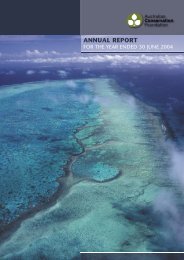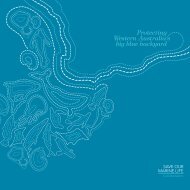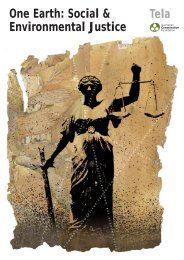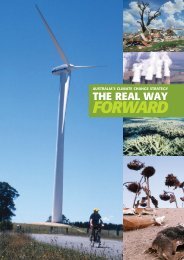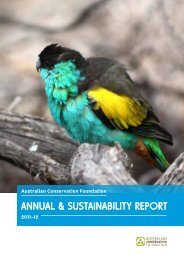Submission on Draft Water Sharing Plan for the Murrumbidgee River
Submission on Draft Water Sharing Plan for the Murrumbidgee River
Submission on Draft Water Sharing Plan for the Murrumbidgee River
You also want an ePaper? Increase the reach of your titles
YUMPU automatically turns print PDFs into web optimized ePapers that Google loves.
Inland <strong>River</strong>s Network and Nature C<strong>on</strong>servati<strong>on</strong> Council submissi<strong>on</strong>:<br />
<strong>Draft</strong> <strong>Water</strong> <strong>Sharing</strong> <strong>Plan</strong> <strong>for</strong> <strong>the</strong> <strong>Murrumbidgee</strong> Regulated <strong>River</strong> <strong>Water</strong> Source – 14 June 2002<br />
• The current Supplementary Envir<strong>on</strong>mental <strong>Water</strong> must be changed to Class A Envir<strong>on</strong>mental Health<br />
<strong>Water</strong> (EHW), so that this water is assured <strong>for</strong> envir<strong>on</strong>mental purposes and in no way c<strong>on</strong>tingent up<strong>on</strong><br />
irrigati<strong>on</strong> allocati<strong>on</strong>s. EHW stored <strong>for</strong> managed release should be increased to 100 gigalitres (GL) per<br />
year, which is c<strong>on</strong>sidered by envir<strong>on</strong>ment groups to be <strong>the</strong> minimum amount required to maintain <strong>the</strong><br />
health of <strong>the</strong> river and its wetlands.<br />
The groups envisage that <strong>the</strong> 100GL EHW volume would not necessarily have to be released each year,<br />
but should be able to be stored, and released c<strong>on</strong>tingent up<strong>on</strong> envir<strong>on</strong>mental triggers. There is significant<br />
ecological benefit in releasing some water following a natural ‘fresh’, with fur<strong>the</strong>r releases after two<br />
weeks depending up<strong>on</strong> tributary flows. A regime such as this will ensure wetlands are adequately<br />
inundated fur<strong>the</strong>r downstream.<br />
• An envir<strong>on</strong>mental flow sub-committee should be <strong>for</strong>med to oversee <strong>the</strong> management of envir<strong>on</strong>mental<br />
water. This could include representatives from local envir<strong>on</strong>ment groups (such as <strong>the</strong> REC), DLWC,<br />
EPA, NPWS, State Forests, scientists and indigenous interests. They would c<strong>on</strong>sider tributary inflows in<br />
deciding <strong>on</strong> <strong>the</strong> timing and volume of water released and incorporate triggers and protocols <strong>for</strong> managed<br />
releases ensuring adequate envir<strong>on</strong>mental water. This could be included as an additi<strong>on</strong>al Schedule 9 to<br />
Part B of <strong>the</strong> <strong>Draft</strong> WSP.<br />
• Translucent release rules in <strong>the</strong> <strong>Draft</strong> WSP <strong>on</strong>ly apply to <strong>the</strong> area below Burrinjuck Dam to <strong>the</strong><br />
c<strong>on</strong>fluence of <strong>the</strong> Tumut <strong>River</strong>. The envir<strong>on</strong>ment groups believe that new translucent rules need to be<br />
developed which are simpler and have dam release triggers that are envir<strong>on</strong>mentally and hydrologically<br />
sound.<br />
• The <strong>Draft</strong> WSP has not put in place appropriate targets to provide <strong>for</strong> <strong>the</strong> recovery of threatened species,<br />
populati<strong>on</strong>s and communities and <strong>the</strong>ir future removal from threatened species listing. The objective to<br />
promote threatened species recovery is c<strong>on</strong>diti<strong>on</strong>al in <strong>the</strong> <strong>Draft</strong> WSP, and <strong>the</strong>re is a low probability that<br />
this will prevent <strong>the</strong> c<strong>on</strong>tinued decline of populati<strong>on</strong>s. The envir<strong>on</strong>ment groups recommend that Part B of<br />
<strong>the</strong> <strong>Water</strong> <strong>Sharing</strong> <strong>Plan</strong> include a schedule of threatened species and facilitate implementati<strong>on</strong> of threat<br />
abatement plans and recovery plans where <strong>the</strong>se species occur. Recovery <strong>Plan</strong>s must be produced<br />
pursuant to <strong>the</strong> Fisheries Management Act 1994 within three years of gazettal and <strong>the</strong> WSP should be<br />
amended to be c<strong>on</strong>sistent with recommendati<strong>on</strong>s made <strong>the</strong>rein. The envir<strong>on</strong>ment groups recommend that<br />
<strong>the</strong> <strong>Draft</strong> WSP acknowledge Key Threatening Processes and reduce or ameliorate <strong>the</strong>se impacts.<br />
• Schedule 8 flows, which determine when water is diverted into <strong>the</strong> Lowbidgee Floodplain District are<br />
totally inadequate in <strong>the</strong> <strong>Draft</strong> WSP and do not account <strong>for</strong>, or protect envir<strong>on</strong>mental water. Fur<strong>the</strong>r, <strong>the</strong><br />
seas<strong>on</strong>ality required <strong>for</strong> ecosystem functi<strong>on</strong> is not c<strong>on</strong>sidered. IRN, NCC and ACF recommend that<br />
Schedule 8 flows in this WSP <strong>for</strong> <strong>the</strong> <strong>Murrumbidgee</strong> Regulated <strong>River</strong> <strong>Water</strong> Source must make provisi<strong>on</strong><br />
<strong>for</strong> envir<strong>on</strong>mental water flows and its seas<strong>on</strong>ality into <strong>the</strong> Lowbidgee Floodplain Districts.<br />
• An envir<strong>on</strong>mental flow sub-committee should be <strong>for</strong>med to oversee <strong>the</strong> development of a water<br />
management plan <strong>for</strong> <strong>the</strong> Lowbidgee Floodplain Districts. This could include representatives from local<br />
envir<strong>on</strong>ment groups (such as <strong>the</strong> REC), DLWC, EPA, NPWS, State Forests, scientists and indigenous<br />
interests of envir<strong>on</strong>mental water.<br />
• The <strong>Draft</strong> WSP has not established adequate flow rules and extracti<strong>on</strong> limits in relati<strong>on</strong> to interim targets<br />
2 and 4 of <strong>the</strong> <strong>Draft</strong> State <strong>Water</strong> Management Outcomes <strong>Plan</strong>. The WSP must be c<strong>on</strong>sistent with <strong>the</strong>se<br />
requirements.<br />
BASIC LANDHOLDER RIGHTS<br />
Native title rights<br />
Advice No. 14 to <strong>Water</strong> Management Committees outlines <strong>the</strong> Committee’s role with respect to Aboriginal<br />
issues and cultural heritage protecti<strong>on</strong>. The Committee’s role is to identify Aboriginal cultural and heritage<br />
values and provide recommendati<strong>on</strong>s <strong>on</strong> how to protect <strong>the</strong>se in <strong>the</strong>ir area as far as <strong>the</strong>y relate to water<br />
sharing. There<strong>for</strong>e <strong>the</strong> plan must include:<br />
- 6 -


